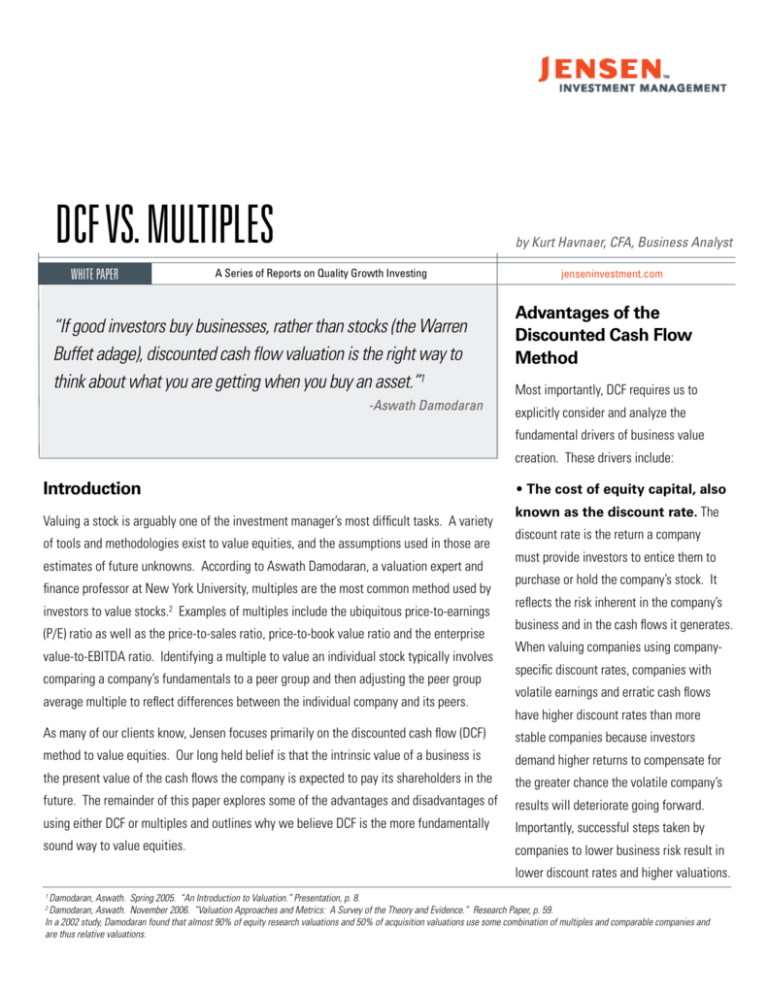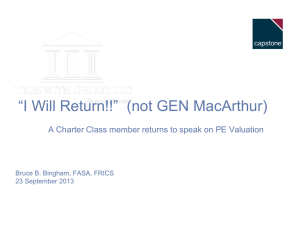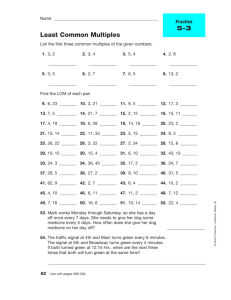
DCF VS. MULTIPLES
white paper
by Kurt Havnaer, CFA, Business Analyst
A Series of Reports on Quality Growth Investing
“If good investors buy businesses, rather than stocks (the Warren
Buffet adage), discounted cash flow valuation is the right way to
think about what you are getting when you buy an asset.”1
-Aswath Damodaran
jenseninvestment.com
Advantages of the
Discounted Cash Flow
Method
Most importantly, DCF requires us to
explicitly consider and analyze the
fundamental drivers of business value
creation. These drivers include:
Introduction
Valuing a stock is arguably one of the investment manager’s most difficult tasks. A variety
of tools and methodologies exist to value equities, and the assumptions used in those are
estimates of future unknowns. According to Aswath Damodaran, a valuation expert and
finance professor at New York University, multiples are the most common method used by
investors to value stocks.2 Examples of multiples include the ubiquitous price-to-earnings
(P/E) ratio as well as the price-to-sales ratio, price-to-book value ratio and the enterprise
value-to-EBITDA ratio. Identifying a multiple to value an individual stock typically involves
comparing a company’s fundamentals to a peer group and then adjusting the peer group
average multiple to reflect differences between the individual company and its peers.
• The cost of equity capital, also
known as the discount rate. The
discount rate is the return a company
must provide investors to entice them to
purchase or hold the company’s stock. It
reflects the risk inherent in the company’s
business and in the cash flows it generates.
When valuing companies using companyspecific discount rates, companies with
volatile earnings and erratic cash flows
have higher discount rates than more
As many of our clients know, Jensen focuses primarily on the discounted cash flow (DCF)
stable companies because investors
method to value equities. Our long held belief is that the intrinsic value of a business is
demand higher returns to compensate for
the present value of the cash flows the company is expected to pay its shareholders in the
the greater chance the volatile company’s
future. The remainder of this paper explores some of the advantages and disadvantages of
results will deteriorate going forward.
using either DCF or multiples and outlines why we believe DCF is the more fundamentally
Importantly, successful steps taken by
sound way to value equities.
companies to lower business risk result in
lower discount rates and higher valuations.
Damodaran, Aswath. Spring 2005. “An Introduction to Valuation.” Presentation, p. 8.
Damodaran, Aswath. November 2006. “Valuation Approaches and Metrics: A Survey of the Theory and Evidence.” Research Paper, p. 59.
In a 2002 study, Damodaran found that almost 90% of equity research valuations and 50% of acquisition valuations use some combination of multiples and comparable companies and
are thus relative valuations.
1
2
2
DCF vs. Multiples
• Return on capital. If the returns on capital deployed
by a business exceed the costs of obtaining that capital, the
company creates value.
Disadvantages of the Discounted Cash
Flow Method
A common criticism of DCF models is that they are more
• Competitive advantages and barriers to entry.
complex than multiples, but building a DCF model does not
Companies with strong brand names, patented products or
require a PhD! In fact, investors armed with Excel and some
significant economies of scale are able to keep competitors
basic math skills are fully capable of constructing a DCF model.
at bay far longer than businesses producing undifferentiated
The difficulty lies in estimating the fundamental drivers of
products facing intense competition. Avoiding a relentless
business value outlined above. Errors in estimating these
onslaught of new competitors enables companies to generate
drivers lead to incorrect intrinsic values.
returns on capital that exceed their costs of capital for
extended periods of time. This, in turn,
Having to forecast uncertain future business results is another
criticism of DCF models. While
can drive higher business values well
into the future.
• Reinvestment rates. As
long as a company’s return on capital
exceeds its cost of capital, reinvesting
At Jensen, our DCF models
reflect the long term
durability of our companies’
competitive advantages.
estimates of future results must be
made in DCF models, many investors
using multiples estimate a stock’s
value by applying those multiples to
projected revenues, EPS or EBITDA.
more of the company’s earnings back
As such, using multiples to estimate
into the business creates additional
value suffers from the same problem
business value.
of having to forecast future business results.
• Growth rates. A company’s earnings growth rate is a
One final criticism of DCF is that the terminal value comprises
function of its return on equity and the amount of earnings
far too much of a company’s value. DCF models typically
reinvested in the business.
include discrete cash flow projections for a period of five to
In addition to explicitly considering the drivers of business
ten years. The value of the business at the end of the discrete
value creation, DCF allows investors to incorporate business
strategy changes into the valuation. For instance, a company
might implement a new productivity improvement program
designed to drive margins higher over time. If the investor
believes the new program will succeed, he or she can build
margin increases into future cash flow estimates. Because
analysts using P/E multiples or enterprise-value-to-EBITDA
multiples usually don’t look beyond the next year or two for
earnings or EBITDA, it would be difficult to incorporate the
expected long term margin benefits of the company’s new
program into a multiples-based valuation.
period is then estimated using a multiple or by assuming
that the company grows at a constant rate into perpetuity.
The value of the business at the end of the discrete period
is commonly referred to as the terminal value. According to
Michael Mauboussin, the Head of Global Financial Strategies
at Credit Suisse, it is not uncommon to see DCF models where
the terminal value represents 60-70% of a company’s total
intrinsic value.3 At Jensen, our DCF models reflect the long
term durability of our companies’ competitive advantages.
This long term view results in terminal values that make up a
relatively small portion of our intrinsic value estimates.
Mauboussin, Michael. 2006. “Common Errors in DCF Models.” Research Paper, p. 4. Legg Mason Capital Management.
3
DCF vs. Multiples
Advantages of Multiples
Simplicity is arguably the greatest virtue of this valuation
technique as multiples are easy to apply and require very basic
math skills. In addition, distant revenues, EPS or EBITDA do not
have to be forecasted because multiples are typically applied to
projections of current year or the next year’s revenues, EPS or
Another disadvantage of this valuation method is that it
assumes the market is correctly valuing the peer group. This
assumption can lead to valuation errors if the entire peer group
is overvalued or undervalued. For instance, a company’s stock
may not be undervalued even though its P/E is lower than its
peers if the market is overvaluing the entire peer group.
In our opinion, the biggest drawback to using multiples is
EBITDA.
Disadvantages Of Multiples
that this method does not explicitly consider whether the
fundamental drivers of business value embedded in the multiple
One of the disadvantages of valuing stocks using multiples is
are reasonable. For example, the formula below tells us that a
that determining the appropriate multiple to use for a given
company’s forward P/E ratio is a function of its cost of equity,
company can be highly subjective because truly comparable
return on equity (ROE), reinvestment ratio and payout ratio:
companies rarely exist.
FPE = Payout Ratio5
k-g
As previously discussed, the multiple used in valuing a
company’s stock is typically determined by calculating the
FPE =
average multiple for a group of comparable companies and
then adjusting the average to reflect fundamental differences
Payout Ratio
k – (ROE * Retention Ratio)
between the company and those peers. All else equal, if a
company’s growth rate is higher than its peers, a multiple that’s
Where,
greater than the peer group average would most likely be used
FPE = forward P/E ratio = Price0/EPS1
to estimate the value of the company’s stock.
Price0 = today’s stock price
EPS1 = earnings per share one year forward
Payout Ratio = proportion of earnings paid out as dividends
k = cost of equity = discount rate
g = earnings growth rate = ROE * Retention Ratio
group is 10%. If the peer group average P/E multiple is 14x,
ROE = return on equity
should the multiple for the individual company be 15x or 16x
Retention Ratio = proportion of earnings reinvested in the business
While this makes logical sense, determining the degree of the
required adjustment from the average multiple is a subjective
exercise. For example, suppose a company’s EPS growth
rate is 15% and the average EPS growth rate for its peer
or even higher? As it relates to this subjective adjustment
for differences between an individual company and its peers,
It’s possible for the ROE embedded in the forward P/E ratio to
we agree with Damodaran when he wrote “many analysts
be unreasonable for a given payout ratio, cost of equity and
adjust for these differences qualitatively, making every relative
retention ratio. Similarly, the retention ratio implied by the
valuation a story telling experience…”4
forward P/E might be unrealistically high or low for a given
payout ratio, cost of equity and ROE.
Damodaran, Aswath. November 2006. “Valuation Approaches and Metrics: A Survey of the Theory and Evidence.” Research Paper, p. 58.
Formula derived as follows:
P0 = Dividend1
P0 = Today’s price
k-g
Dividend1 = One year forward dividend to be paid = EPS1 * payout ratio1
k = Cost of equity = Discount rate
P0 = EPS1 * Payout Ratio
g = Earnings growth rate
k–g
EPS1 = One year forward earnings
Payout ratio = Proportion of earnings to be paid out as a dividend
P0 = Payout Ratio
P0/EPS1 = Forward P/E ratio
4
5
EPS1
k-g
3
4
DCF vs. Multiples
In contrast to using multiples for valuation, DCF makes explicit
multiples whereas they are explicitly estimated with DCF. As
estimates of all of the fundamental drivers of business value.
indicated above, we believe it is more important to estimate
While it’s not always easy to make these estimates, we believe
and analyze those valuation drivers than it is to let the multiple
it is far more important to make reasonable forecasts of these
do that important work for us.
fundamentals than to rely blindly upon a multiple in which the
drivers of business value are simply implied.
In summary, we agree with Mauboussin when he wrote “Some
investors swear off the DCF model because of its myriad
assumptions. Yet they readily embrace an approach that packs
Conclusion
all of those same assumptions, without any transparency, into a
Pros and cons exist for both of the valuation techniques
represent shorthand for the valuation process. Like most forms
discussed above. This also holds true for other valuation
of shorthand, multiples come with blind spots and biases that
methods. The irony in comparing and contrasting multiples and
few investors take the time and care to understand.”
single number: the multiple. Multiples are not valuation; they
DCF is that multiples are merely a simplified version of DCF. All
of the fundamental drivers of business value are incorporated
in both techniques, but those drivers are implied when using
All factual information contained in this paper is derived from sources which Jensen believes are reliable, but Jensen cannot guarantee
complete accuracy.
Any charts, graphics, or formulas contained in this piece are only for the purpose of illustration. The views of Jensen Investment Management expressed herein are not intended to be a forecast of future events, a guarantee of future results, nor investment advice. Past
performance does not guarantee future results.
The Jensen Quality Growth Fund is non-diversified, meaning that it may concentrate its assets in fewer
individual holdings than a diversified fund, and therefore is more exposed to individual stock volatility
than a diversified fund.
Investing involves risks; loss of principal is possible.
EBITDA: Earnings Before Interest, Taxes, Depreciation, and Amortization
Earnings Growth = return on equity * earnings retention ratio.
Price to Earnings (P/E) Ratio: Is a common tool for comparing the prices of different common stocks and is calculated by dividing the
current market price of a stock by the earnings per share.
PRICE/BOOK RATIO: The weighted average of the price/book value of ratios of the equity securities referenced. The P/B ratio is
calculated by dividing current price of the stock by the company’s book value per share.
Enterprise Value to EBITDA Ratio (EV/EBITDA): Enterprise value multiple is the comparison of enterprise value and earnings before
interest, taxes, depreciation and amortization.
Price to Sales Ratio (P/S): The P/S ratio measures the price of a company’s stock against its annual sales.
5300 Meadows Road, Suite 250
Lake Oswego, OR 97035
800.221.4384
The Fund’s investment objectives, risks, charges and expenses must be considered carefully before investing. The prospectus contains this and other important information about the investment company, and it may
be obtained by calling 1.800.992.4144, or by visiting jenseninvestment.com. Read
it carefully before investing.
Quasar Distributors, LLC – Distributor
jenseninvestment.com
© 2012 Jensen Investment Management. The Jensen Quality Universe is a trademark of Jensen Investment Management. All rights reserved.








